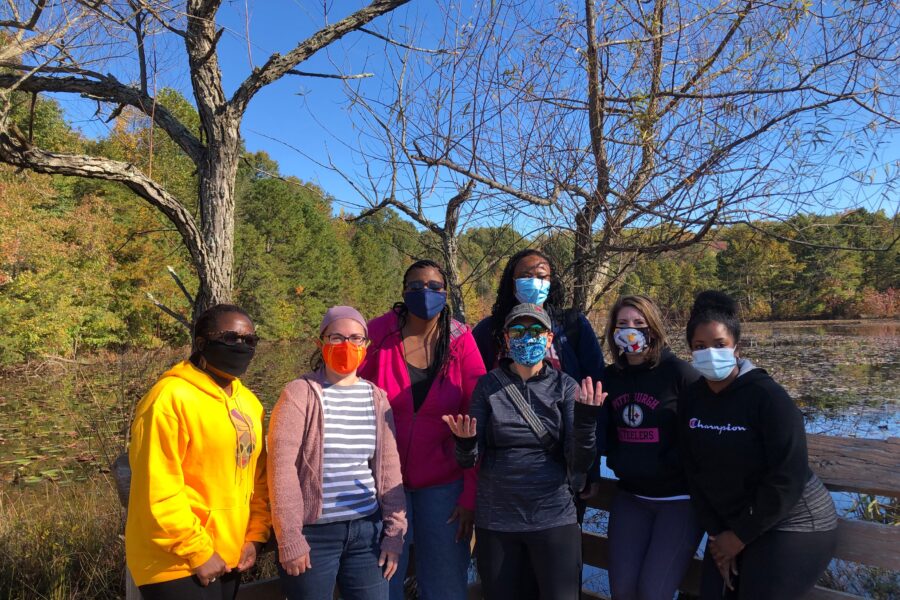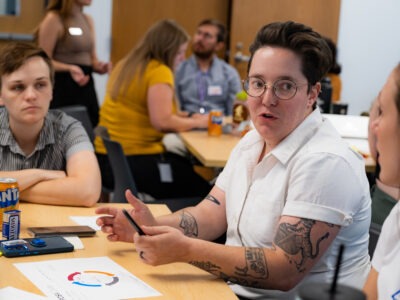Amanda Harris said it is both the worst and best time to work in homeless services.
She understands first and foremost, that the stakes are higher than ever, with COVID-19 threatening the lives of people experiencing homelessness. Simultaneously, the pandemic response has triggered greater resources for homelessness than ever before.
“This is a once-in-a-lifetime opportunity,” she said. “We have an opportunity to make a serious dent in homelessness.”
Harris works as the Chief of Services to End and Prevent Homelessness for the Montgomery County Department of Health and Human Services. The community is one of the 14 communities in Built for Zero that have reached functional zero, a milestone for solving homelessness for a population.
The Maryland community announced they reached this milestone and effectively ended veteran homelessness in December 2015. Since then, the community has worked to sustain functional zero for veteran homelessness, while reducing both chronic and family homelessness on its journey to ending homelessness for all.
“We are trying our hardest to be as strategic as possible,” she said. “We want to capitalize on this opportunity.”

“This is a once-in-a-lifetime opportunity. We have an opportunity to make a serious dent in homelessness.”
— Amanda Harris
Collaborative system aimed at ending homelessness
In Montgomery County, all the leaders of homelessness services meet twice a month to coordinate housing placements for people on their by-name list. In those meetings, all the members provide updates on their progress toward their shared goals.
This includes, for example, a goal of sustaining functional zero for veteran homelessness. For Montgomery County, that means working to ensure six or fewer veterans are experiencing homelessness.
“It’s keeping track of that number and making sure we’re talking about it,” she said. “And through our by-name list, we know every veteran and are able to talk about them — if we’re facing challenges getting them into a placement, or if they need a higher level of care. Knowing them by name is critical.”
As Harris added, having the community’s commitment to the goal of ending homelessness and the ability to track their progress were particularly prudent during the pandemic response.
“Being in homeless services can be incredibly overwhelming during COVID-19,” she said. “We were very focused on keeping people safe and, at the same time, we wanted to make sure we weren’t losing sight of the ultimate goal of ending homelessness.”
Harnessing federal resources
Through COVID-19 recovery and relief, communities have had access to historic amounts of funding to address homelessness and housing instability. Braiding together funding from various sources, Montgomery County has been able to target resources to help end and prevent homelessness and offer more choices to their clients.
“It’s going to be hard, and people will be stressed,” she said. “But we can’t waste this opportunity.”
For example, Montgomery County has used Emergency Solutions Grant funding to expand rapid rehousing, initially focusing on getting families connected to housing. Now, the county is working to scale rapid rehousing for single adults experiencing homelessness. Through the Coronavirus Relief Fund, the community was able to dedicate resources for eviction prevention and provide six-month subsidies to help their clients exit homelessness. Due to the flexibility of that funding, the community was able to establish a direct cash assistance program, which provides $5,000 to community members in the shelter system. The community is now preparing to use funding through the Emergency Rental Assistance Program to help even more people exit homelessness in addition to preventing evictions.
Harris sees this moment not only as an opportunity to help more individuals exit and avoid entering into homelessness, but to create proof of what can work to accelerate their journey to zero..
“Even though it’s one-time money, we are tracking outcomes and testing things,” she said. “We want to be able to prove that if you can bring resources to the table, we can actually end homelessness.”
Inflow
“We want to work together to figure out how we can prevent people from entering our system altogether.”
Amanda harris
Harris understands that reaching functional zero, and sustaining that end, requires addressing upstream systems that contribute to homelessness.
“We know that homelessness is the result of other failed systems,” she said. “We want to make sure that we’re including those feeder systems into our process so they know what we’re doing and help us move that work further upstream. We want to work together to figure out how we can prevent people from entering our system altogether.”
Across the country, there has been a growing concern around the impact of the expiration of the CDC eviction moratorium. Harris observed that the court system generally moves more slowly, and that the consequence of that expiration may not look like an immediate tsunami of evictions in her community. Instead, she is concerned about a prolonged, long-term impact on families and community members.
“What worries me is about the unstably housed and more people being doubled up, more people on the edge,” she said. “I’m worried about what happens a year, two years from now when all those federal resources have dried up and people are still struggling.”
The road ahead
Harris said that her community is committed to moving toward an end to all homelessness. In the meantime, she hopes this moment serves as a critical inflection point that will influence policies and decisions that accelerate our collective ability to end homelessness.
“I hope that we will move the needle to housing as an entitlement,” she said. “We have had a housing crisis for decades now. I hope that the powers that be, the decision-makers, understand that we have to do something different. We need more affordable housing. We need more subsidies. We need to ensure we never have to worry about a looming eviction tsunami.”




